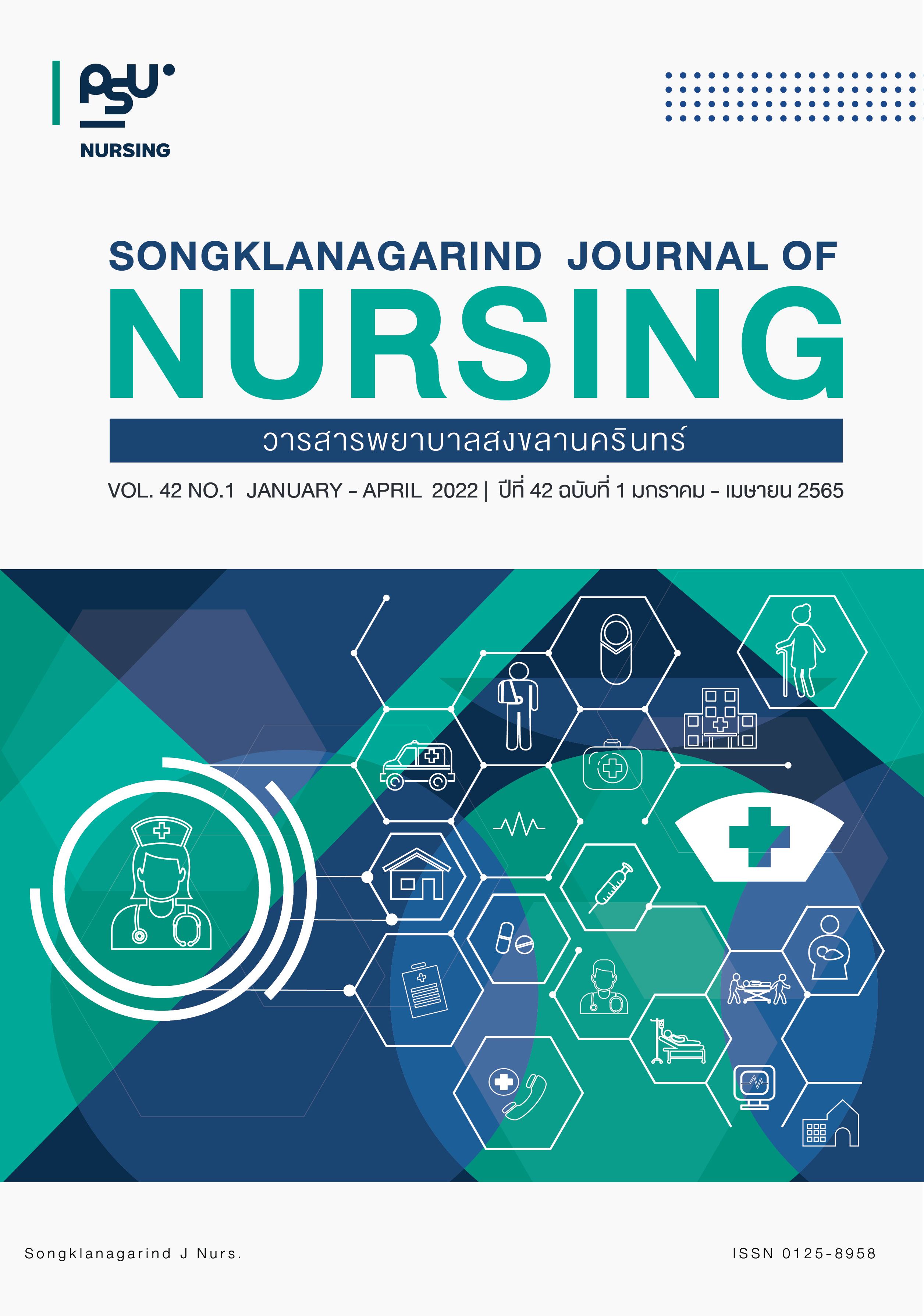Effects of Using Chest Vibration Innovation on the Efficacy of Secretion Drainage in Children with Pneumonia
Main Article Content
Abstract
Objective: The purpose of this quasi-experimental study was to compare effects of using chest vibration innovation on the efficacy of secretion drainage in children with pneumonia. The sample group consisted of children with pneumonia admitted to the pediatric ward. Methods: The subjects were recruited using a convenience sampling and participants group (n = 25) received chest vibration innovation as well as standard treatment for pneumonia. The control group (n = 25) received manual physical therapy and standard treatment for pneumonia. Respiratory rate, pulse rate, oxygen saturation, position of secretion sound, and secretion volume were used to evaluate the efficacy of secretion drainage. Descriptive statistics, independent t-test and Mann-Whitney U test were employed to analyze the research data. Results: The results demonstrated that the mean scores of all clinical resolution after 2 and 5 minutes in the experiment and control groups were not different (p > .05). After the experiment, the mean scores of respiratory rates, pulse rates, and position of secretion sound in both groups were decreased. While, after the experiment, the mean score of oxygen saturation in both groups were increased than before the experiment. Conclusion: The use of the chest vibration innovation did, in fact, promote secretion drainage in children with pneumonia. As a result, nurses should apply chest vibration innovation to improve efficacy of secretion drainage.
Article Details

This work is licensed under a Creative Commons Attribution-NonCommercial-NoDerivatives 4.0 International License.
References
Nguyen P, Tran HT, Fitzgerald DA, et al. Characterisation of children hospitalised with pneumonia in central Vietnam: A prospective study. Eur Respir J. 2019; 51(1): 1-10. doi: 10.1183/13993003.02256-2018.
The Thai society of pediatric respiratory and critical care medicine. Pneumonia. In: The Thai society of pediatric respiratory and critical care medicine, editors. Guideline for acute respiratory infection of pediatric 2019. Nonthaburi: Beyond enterprise company; 2019. Thai.
Mani CS. Acute pneumonia and its complications. Principles and practice of pediatric infectious diseases. 2018: 238-49. e4. doi: 10.1016/B978-0-323-40181-4.00034-7.
AO, XX. The epidemiology of hospital death following pediatric severe community acquired pneumonia. Ital J Pediatr. 2021; 47(1): 25. doi: 10.1186/s13052-021-00966-0.
Jaikran T, Wongcharoen N. Incidence rates and impact of pneumonia in Pong hospital. JRTAN. 2021; 22(1): 351-9. Thai.
McAllister DA, Liu L, Shi T, et al. Global, regional, and national estimates of pneumonia morbidity and mortality in children younger than 5 years between 2000 and 2015: A systematic analysis. Lancet Glob Health. 2019; 7(1): e47-57. doi: 10.1016/S2214-109X(18)30408-X.
Seanpook W, Srisong S, Sansuriwong P. The Development of the care model for children with pneumonia. JRTAN. 2020; 47(1): 153-72. Thai.
Satdhabudha A. Acute pneumonia. In: Intarakhao S, Jungtheerapanich J, Sinlapamongkolkul P, et al, editors. Textbook of pediatric. Pathum Thani: Thammasat printing house; 2018. Thai.
Conlon P. The child with respiratory dysfunction. In: Hockenberry MJ, Wilson D, Rodgers CC, editors. Wong’s nursing care of infants and children. 11 th ed. St. Louis, Missouri: Elsevier; 2019.
Odeyemi AO, Oyedeji AO, Adebami OJ, et al. Complications of pneumonia and its associated factors in a pediatric population in Osogbo, Nigeria. Niger J Paediatr. 2020; 47(4): 318-23.
Pozuelo-Carrascosa DP, Torres-Costoso A, Alvarez-Bueno C, et al. Multimodality respiratory physiotherapy reduces mortality but may not prevent ventilator-associated pneumonia or reduce length of stay in the intensive care unit: A systematic review. J Physiother. 2018; 64(4): 222-28. doi: 10.1016/j.jphys.2018.08.005.
Chaves GS, Freitas DA, Santino TA, et al. Chest physiotherapy for pneumonia in children. Cochrane Database Syst Rev. 2019(1): CD010277. doi: 10.1002/14651858.CD010277.pub3.
Spinou A, Chalmers JD. Using airway clearance techniques in bronchiectasis: Halfway there. Chest. 2020; 158(4): 1298-300. doi: 10.1016/j.chest.2020.07.062.
Leemans G, Belmans D, Holsbeke CV, et al. The effectiveness of a mobile high-frequency chest wall oscillation (HFCWO) device for airway clearance. Pediatr Pulmonol. 2019; 55(8): 1984-92. doi: 10.1002/ppul.24784.
Abdelbasset WK, Elnegamy T. Effect of chest physical therapy on pediatrics hospitalized with pneumonia. IJHRS. 2015; 4(4): 219-26. doi: 10.5455/ijhrs.000000095.
CUI Inc. IEC 60601-1: Medical design standards for power supples [Internet]. 2019 [cited 2021 Dec 29]. Available from: https://www.cui.com/catalog/resource/download/iec-60601-1-medical-design-standards.pdf
Donabedian A. An Introduction to quality assurance in health Care. Oxford: Oxford University Press; 2003.
Chohen J. Statistical power analysis for the behavioral sciences. 2 nd ed. Hillsdale, NJ: Lawrence Erlbaum Associates; 1988.
Hussein HA, Elsamman GA. Effect of chest physiotherapy on improving chest airways among infants with pneumonia. J Am Sci. 2011; 7(9): 460-6.
Longhini F, Bruni A, Garofalo E, et al. Chest physiotherapy improves lung aeration in hypersecretive critically ill patients: A pilot randomized physiological study. Crit Care. 2020; 24(1): 479. doi: 10.1186/s13054-020-03198-6.
Kluayhomthong S, Khrisanapant W, Chaisuksant S, et al. Effectiveness of a new breathing device “BreatheMAX®” to increase air way secretion clearance in patients with ventilatory dependence. J Med Tech Phy Ther. 2011; 22(1): 96-108. Thai.
Lestari NE, Nurhaeni N, Chodidjah S. The combination of nebulization and chest physiotherapy improved respiratory status in children with pneumonia. Enferm Clin. 2018; 28(suppl 1): 19-22.
Corten L, Jelsma J, Human A, et al. Assisted autogenic drainage in infants and young children hospitalized with uncomplicated pneumonia, a pilot study. Physiother Res Int. 2018; 23(1): e1690. doi: 10.1002/pri.1690.
Ginderdeuren FV, Vandenplas Y, Deneyer M, et al. Effectiveness of airway clearance techniques in children hospitalized with acute bronchiolitis. Pediatr Pulmonol. 2017; 52(2): 225-31. doi: 10.1002/ppul.23495.
Tovichien P, Satdhabudha A. Chest physiotherapy for pneumonia in children. In: Sirithangul S, Udomittipong K, Jetanachai P, editors. Sharpen your practice in pediatric respiratory disease. Bangkok: Beyound enterprise company; 2020. Thai.


